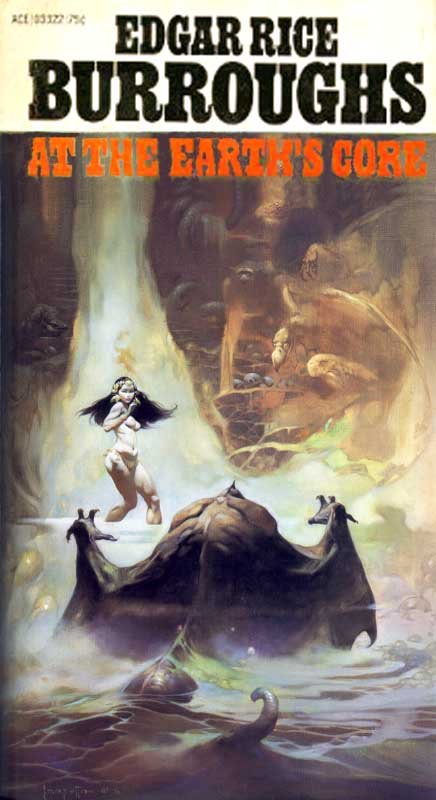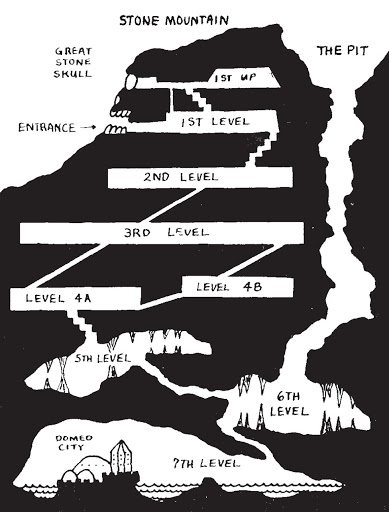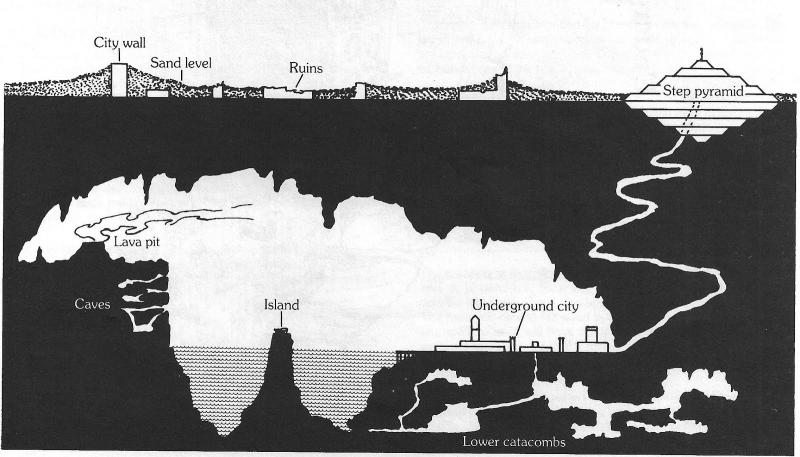RETROSPECTIVE: At the Earth’s Core, by Edgar Rice Burroughs
Monday , 1, September 2014 Appendix N 9 Comments When a Connecticut born mining operator goes to visit his dilettante paleontologist friend that has constructed a “mechanical subterranean prospector,” an “iron mole” with “a mighty revolving drill” capable of tunneling through the earth at unparalleled speed, things quickly go off the rails. Not five paragraphs into the story, the two are on board the hundred foot long machine tunneling through the earth. Predictably the machine ends up tunneling straight down with the steering controls locked. They avoid burning up in the intense heat, they nearly die when the oxygen tanks run out, and everything seems lost… but then, the machine breaks through the surface. For a moment it appears that they might have turned around while inside an ice strata at some point causing them to resurface in a random location, but then they notice that things are not as they seem:
When a Connecticut born mining operator goes to visit his dilettante paleontologist friend that has constructed a “mechanical subterranean prospector,” an “iron mole” with “a mighty revolving drill” capable of tunneling through the earth at unparalleled speed, things quickly go off the rails. Not five paragraphs into the story, the two are on board the hundred foot long machine tunneling through the earth. Predictably the machine ends up tunneling straight down with the steering controls locked. They avoid burning up in the intense heat, they nearly die when the oxygen tanks run out, and everything seems lost… but then, the machine breaks through the surface. For a moment it appears that they might have turned around while inside an ice strata at some point causing them to resurface in a random location, but then they notice that things are not as they seem:
As I looked I began to appreciate the reason for the strangeness of the landscape that had haunted me from the first with an illusive suggestion of the bizarre and unnatural–THERE WAS NO HORIZON! As far as the eye could reach out the sea continued and upon its bosom floated tiny islands, those in the distance reduced to mere specks; but ever beyond them was the sea, until the impression became quite real that one was LOOKING UP at the most distant point that the eyes could fathom–the distance was lost in the distance. That was all–there was no clear-cut horizontal line marking the dip of the globe below the line of vision….
I glanced up to find the great orb still motionless in the center of the heaven. And such a sun! I had scarcely noticed it before. Fully thrice the size of the sun I had known throughout my life, and apparently so near that the sight of it carried the conviction that one might almost reach up and touch it. (Chapter 2)
After some encounters the local fauna, the two travelers realize that there is some sort of new world on the inside of the earth. Now, a hollow earth is one thing, and the whole idea of a lost world is great, but Edgar Rice Burroughs has gone to an inconceivably fantastic level by having a sun inside the earth to light this strange domain. The nutty professor type character explains how it can be:
“The earth was once a nebulous mass. It cooled, and as it cooled it shrank. At length a thin crust of solid matter formed upon its outer surface–a sort of shell; but within it was partially molten matter and highly expanded gases. As it continued to cool, what happened? Centrifugal force burled the particles of the nebulous center toward the crust as rapidly as they approached a solid state. You have seen the same principle practically applied in the modern cream separator. Presently there was only a small super-heated core of gaseous matter remaining within a huge vacant interior left by the contraction of the cooling gases. The equal attraction of the solid crust from all directions maintained this luminous core in the exact center of the hollow globe. What remains of it is the sun you saw today–a relatively tiny thing at the exact center of the earth. Equally to every part of this inner world it diffuses its perpetual noonday light and torrid heat.
“This inner world must have cooled sufficiently to support animal life long ages after life appeared upon the outer crust, but that the same agencies were at work here is evident from the similar forms of both animal and vegetable creation which we have already seen. Take the great beast which attacked us, for example. Unquestionably a counterpart of the Megatherium of the post-Pliocene period of the outer crust, whose fossilized skeleton has been found in South America.”
“But the grotesque inhabitants of this forest?” I urged. “Surely they have no counterpart in the earth’s history.”
“Who can tell?” he rejoined. “They may constitute the link between ape and man, all traces of which have been swallowed by the countless convulsions which have racked the outer crust, or they may be merely the result of evolution along slightly different lines–either is quite possible.” (Chapter 3)
With the help of a library in an underground city, they discover more about the geography of this strange place:
“Look,” he cried, pointing to it, “this is evidently water, and all this land. Do you notice the general configuration of the two areas? Where the oceans are upon the outer crust, is land here. These relatively small areas of ocean follow the general lines of the continents of the outer world.
“We know that the crust of the globe is 500 miles in thickness; then the inside diameter of Pellucidar must be 7,000 miles, and the superficial area 165,480,000 square miles. Three-fourths of this is land. Think of it! A land area of 124,110,000 square miles! Our own world contains but 53,000,000 square miles of land, the balance of its surface being covered by water. Just as we often compare nations by their relative land areas, so if we compare these two worlds in the same way we have the strange anomaly of a larger world within a smaller one! (Chapter 5)
And finally, almost as an afterthought, Burroughs introduces one more mind blowing element to his inner world:
“What is the Land of Awful Shadow?” I asked.
“It is the land which lies beneath the Dead World,” replied Dian; “the Dead World which hangs forever between the sun and Pellucidar above the Land of Awful Shadow. It is the Dead World which makes the great shadow upon this portion of Pellucidar.”
I did not fully understand what she meant, nor am I sure that I do yet, for I have never been to that part of Pellucidar from which the Dead World is visible; but Perry says that it is the moon of Pellucidar–a tiny planet within a planet–and that it revolves around the earth’s axis coincidently with the earth, and thus is always above the same spot within Pellucidar. (Chapter 15)
Taken together, this is so audacious as to be utterly confounding. It’s the little things that make it seem real, though. With no stars and no day or night, the inner world becomes strangely timeless and navigation is impossible. Not that there aren’t flaws in the implementation. Written in 1914, it’s no surprise that the author trots out the word “Negro” at some point. The paleontology is likewise dated. There’s an awful lot of goofy coincidences holding the plot together, too. It becomes painfully clear, though, that our baseline concepts of romance are essentially medieval in origin. The stock love interest arc developed in Princess of Mars is completely out of place when it is recast into some kind of prehistoric milieu. “Dian the Beautiful” might be a fine specimen, but she pales in comparison to the daughter of a thousand jeddaks. Plus, the way she screams, “I hate you!” at the hero throughout the book gets grating after a while.
It’s the casual way in which the protagonists initiate a combination of uplift, revolution, and missionary work that is going to be so striking today, however:
“Why, Perry,” I exclaimed, “you and I may reclaim a whole world! Together we can lead the races of men out of the darkness of ignorance into the light of advancement and civilization. At one step we may carry them from the Age of Stone to the twentieth century. It’s marvelous–absolutely marvelous just to think about it.”
“David,” said the old man, “I believe that God sent us here for just that purpose–it shall be my life work to teach them His word–to lead them into the light of His mercy while we are training their hearts and hands in the ways of culture and civilization.”
“You are right, Perry,” I said, “and while you are teaching them to pray I’ll be teaching them to fight, and between us we’ll make a race of men that will be an honor to us both.” (Chapter 5)
Fortunately the book never really devolves into some kind of paper thin morality play. The peoples of Pellucidar are their own thing… not stand-ins for real world nations or people groups. The ape-men with prehensile tales are the minions of the dominate species of the underworld: winged lizard people with strange telepathic powers. The ape-men capture the human-like cave men and cave women and force them to work as slaves for their overlords. Meanwhile, other groups of cave people have cut a deal with the lizard folk: they will capture people from enemy tribes and deliver them to temples where they are eaten in diabolical rituals. Evidently this latter activity would be offensive to the ape-man minions if they knew of it, so it has to occur in locations remote from the core of the lizard peoples’ civilization.

People that entered the hobby via the Holmes Basic D&D set were liable to pick up a much more audacious approach to dungeon design thanks to this famous cross section.
It isn’t immediately obvious what the right thing to do with this situation is, but it’s rich enough (and straight-forward enough) that it would be interesting to see how table top role-playing gamers respond to it. Usually in games the good guys and bad guys are clearly demarcated, and the scenario objectives are generally pretty clear. A lot of adventuring boils down to a combination of investigation and exploration that just so happens to end with a climatic “boss” encounter. That style of play is so easy to run that even a computer can do it! While the classic module The Island of Dread does introduce a comparable number of factions as what is seen here, it does not delve overmuch into the possibilities for how the players can alter the status quo in their balance of power the way that Burroughs does.
I think the thing that actually got translated from this book into early D&D culture is a willingness to put an epic payoff in the strangest places. You can see this in the iconic Stone Mountain dungeon from the first Basic Set edited by J. Eric Holmes where there is a entire domed city on the seventh level on an island in an underground lake. In Tom Moldvay’s B4 The Lost City, the titular metropolis turns out to be deep in the earth in a vast underground far below the well trod levels of the ziggurat. I always thought this was pretty ambitious stuff, but compared to Edgar Rice Burroughs, this is actually somewhat tame. But these underground cities are like the inner world of Pellucidar in that they require something more than the usual dungeon crawling premise to translate them into actual gameplay.
What exactly is to be done with those cities is something that is only hinted at worked out in either rule sets or adventure modules. Burroughs’s solution to this design problem with Pellucidar is actually pretty interesting:
Ghak and Dacor reached a very amicable arrangement, and it was at a council of the head men of the various tribes of the Sari that the eventual form of government was tentatively agreed upon. Roughly, the various kingdoms were to remain virtually independent, but there was to be one great overlord, or emperor. It was decided that I should be the first of the dynasty of the emperors of Pellucidar.
We set about teaching the women how to make bows and arrows, and poison pouches. The young men hunted the vipers which provided the virus, and it was they who mined the iron ore, and fashioned the swords under Perry’s direction. Rapidly the fever spread from one tribe to another until representatives from nations so far distant that the Sarians had never even heard of them came in to take the oath of allegiance which we required, and to learn the art of making the new weapons and using them.
We sent our young men out as instructors to every nation of the federation, and the movement had reached colossal proportions before the Mahars discovered it. The first intimation they had was when three of their great slave caravans were annihilated in rapid succession. They could not comprehend that the lower orders had suddenly developed a power which rendered them really formidable. (Chapter 15)
The crucial element in the action here lies in how the characters form alliances and play different groups off of each other. This is echoed in how the the players are expected to engage with the various monster tribes of Gary Gygax’s B2 Keep on the Borderlands. People rarely played the game in that manner because there is little in the rules to assist the novice Dungeon Master: so many of the rulings that will have to be made should the players attempt something along those lines come down to little more than judgement calls. The fact that large swaths of play end up taking place outside the scope of the rules is exactly what makes it fun. However, if you want to transition into something closer to this type of domain level play early on, you’re going to have be be comfortable in allowing for diplomacy rather than simply expecting the players to be able to systematically “clean out” the adventure location with only their own resources. Indeed, current notions of encounter balance have to go out the window in order to force the players to start getting creative.
Violence isn’t the answer to this one. Not initially, anyway…. Not that there isn’t furious action and a large set-piece battle in the book, but with Edgar Rice Burroughs, when you delve deep enough into the earth you end up in a Foundation type scenario, a 4X strategy game along the lines of Sid Meier’s Civilization. As Ryan Harvey said over at The Black Gate, Burroughs “re-shaped popular fiction, helped change the United States into a nation of readers, and created the professional fiction writer.” His contributions to fiction are enormous, but his contribution to gaming included what can only be the biggest dungeon ever conceived. It’s awe inspiring, it’s epic in its scope… and loaded with possibilities.
Yet another fine example of why Castalia House is on my daily reading list.
-
Thank you! Mighty glad to be here!
B4 was the very first module I ever owned and DMed…before I ever got the boxed set of rules. Still one of my fondest game memories, of any game ever played. Not knowing what I didn’t know brought in details and resolutions that never would have happened had I known what the rules were.
-
One of the few modules that can rival Gygax’s B2. It’s the first one I remember running for a group, too. Alas, I never completed the design or let the players make it to that underground city.
Another epic post. The remarkable thing is that it’s almost as if Burroughs should be credited for creating the Steampunk genre as well. I suppose it’s not all that “punk”, but when you’re talking about fiction based on presumably steam-powered might revolving drills, you’re not all that far off.
-
It doesn’t quite say steam, but it’s got a wacky comic book power source:
At one end is a mighty revolving drill operated by an engine which Perry said generated more power to the cubic inch than any other engine did to the cubic foot. I remember that he used to claim that that invention alone would make us fabulously wealthy….
That’s the classic comic book approach: like when a super villain that could be a millionaire just with his tech would rather use it to fight dudes that run around in their pajamas. Riiiiight.
Naturally, I particularly like your comparison between the Basic sample dungeon & the Pellucidar series. I hadn’t thought about the parallels between the “endgames” before. As you know, Holmes himself wrote an authorized sequel to the Pellucidar series, Mahars of Pellucidar (1976), that prominently features one of the underground Mahar cities. So an enterprising DM might stick Holmes’ own depiction of a Mahar city in the Domed City of the Sample Dungeon.
-
I wonder if the parallel isn’t tenuous. I mean… if there’s something significant about the Holmes basic set that you haven’t already posted on, well…! But thanks. I’d stumbled across Holmes’s Pellucidar book before I understood what it was. I’m really curious to see what he did with the setting now.
[…] Bushi beat me to the punch, and Jeffro wrote a full retrospective back in 2014, so I’m not going to do a full review of At the Earth’s […]
